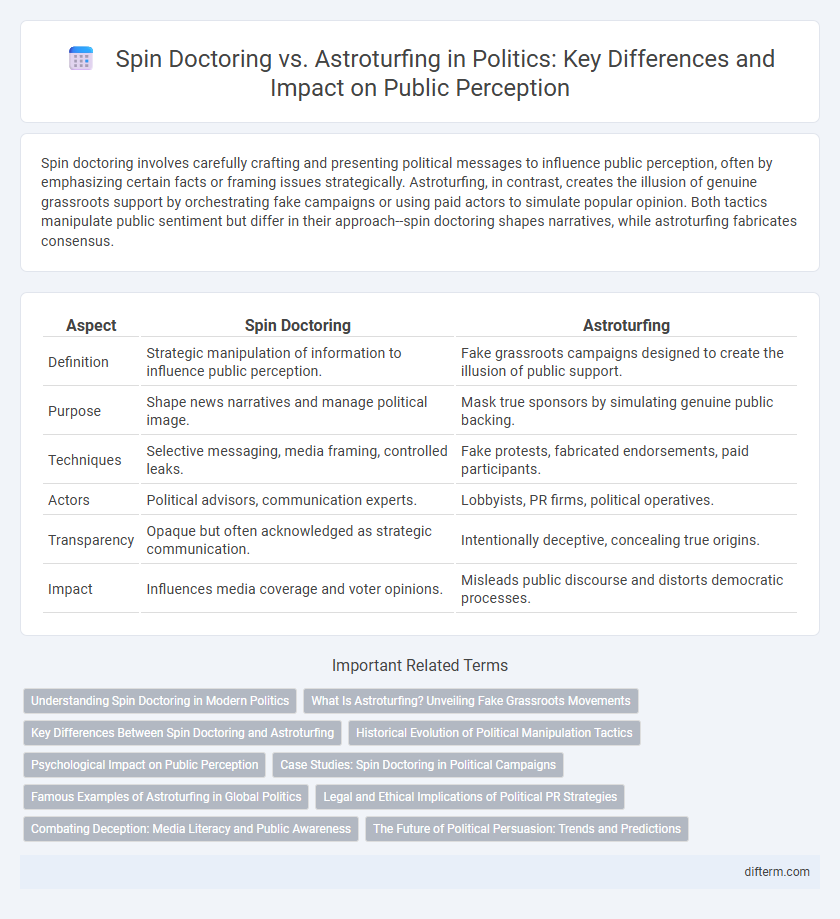Spin doctoring involves carefully crafting and presenting political messages to influence public perception, often by emphasizing certain facts or framing issues strategically. Astroturfing, in contrast, creates the illusion of genuine grassroots support by orchestrating fake campaigns or using paid actors to simulate popular opinion. Both tactics manipulate public sentiment but differ in their approach--spin doctoring shapes narratives, while astroturfing fabricates consensus.
Table of Comparison
| Aspect | Spin Doctoring | Astroturfing |
|---|---|---|
| Definition | Strategic manipulation of information to influence public perception. | Fake grassroots campaigns designed to create the illusion of public support. |
| Purpose | Shape news narratives and manage political image. | Mask true sponsors by simulating genuine public backing. |
| Techniques | Selective messaging, media framing, controlled leaks. | Fake protests, fabricated endorsements, paid participants. |
| Actors | Political advisors, communication experts. | Lobbyists, PR firms, political operatives. |
| Transparency | Opaque but often acknowledged as strategic communication. | Intentionally deceptive, concealing true origins. |
| Impact | Influences media coverage and voter opinions. | Misleads public discourse and distorts democratic processes. |
Understanding Spin Doctoring in Modern Politics
Spin doctoring in modern politics involves crafting and strategically releasing information to shape public perception and influence media narratives, often by political consultants or communication experts. This practice focuses on controlling the message to benefit a politician or party, differentiating it from astroturfing, which fabricates grassroots support to simulate genuine public opinion. Mastery of spin doctoring enables political actors to navigate crises, manipulate controversies, and maintain favorable images through calculated media management.
What Is Astroturfing? Unveiling Fake Grassroots Movements
Astroturfing involves orchestrated campaigns that masquerade as genuine grassroots movements to manipulate public opinion and policy decisions. Unlike organic activism, these fake grassroots efforts employ deceptive tactics such as fake social media profiles, paid supporters, and fabricated petitions to create an illusion of widespread citizen support. Understanding astroturfing is crucial for discerning authentic political engagement from contrived propaganda orchestrated by special interest groups or political operatives.
Key Differences Between Spin Doctoring and Astroturfing
Spin doctoring involves manipulating information and media to positively influence public perception of politicians or policies, often through strategic communication and framing. Astroturfing, in contrast, creates a false impression of grassroots support by organizing deceptive campaigns that appear as spontaneous citizen movements. The key difference lies in spin doctoring's emphasis on messaging control, whereas astroturfing focuses on fabricating public consensus.
Historical Evolution of Political Manipulation Tactics
Spin doctoring emerged prominently in the late 20th century as political strategists refined techniques to shape public perception through controlled messaging and media influence. Astroturfing, a more deceptive tactic, evolved alongside digital communication in the early 2000s, creating artificial grassroots movements to simulate genuine public support. Both methods reflect the ongoing evolution of political manipulation, shifting from traditional media spin to sophisticated digital disinformation campaigns.
Psychological Impact on Public Perception
Spin doctoring manipulates public perception by framing political information to evoke desired emotional responses, often emphasizing positive aspects while downplaying negatives to influence voter attitudes. Astroturfing creates the illusion of grassroots support, psychologically amplifying the perceived popularity and legitimacy of a political message, which can sway undecided individuals by leveraging social proof. Both tactics exploit cognitive biases, such as confirmation bias and social conformity, to subtly shape public opinion and reinforce political agendas.
Case Studies: Spin Doctoring in Political Campaigns
Spin doctoring in political campaigns involves strategic communication techniques used to shape public perception, often exemplified by the 1992 U.S. presidential campaign where James Carville crafted the "It's the economy, stupid" narrative to focus voter attention. Another prominent case is Tony Blair's 1997 Labour Party campaign, with Alastair Campbell managing media relations to present a modernized party image and control opposition narratives. These campaigns highlight how spin doctors manipulate media framing and messaging to influence voter behavior and political outcomes.
Famous Examples of Astroturfing in Global Politics
Famous examples of astroturfing in global politics include the 2014 Ukrainian crisis, where pro-Russian groups orchestrated fake grassroots protests to sway international opinion. In the United States, the Tea Party movement is often cited as partially astroturfed, with substantial financial backing from powerful political interests disguised as spontaneous citizen activism. Another notable case is the 2020 Hong Kong protests, where both pro-Beijing and pro-democracy factions accused each other of astroturfing to manipulate public perception and media narratives.
Legal and Ethical Implications of Political PR Strategies
Spin doctoring manipulates public perception through strategic communication, often blurring ethical boundaries but typically operating within legal frameworks. Astroturfing, involving the creation of fake grassroots movements, poses significant legal risks due to deceptive practices undermining electoral transparency and can provoke regulatory penalties. Both strategies challenge democratic principles, raising concerns about accountability, misinformation, and the erosion of public trust in political processes.
Combating Deception: Media Literacy and Public Awareness
Combating deception in politics requires enhancing media literacy to identify spin doctoring and astroturfing tactics often used to manipulate public opinion. Public awareness campaigns focused on recognizing fabricated grassroots movements and distorted political messaging empower citizens to critically evaluate sources. Strengthening digital literacy skills helps counteract these covert influence operations, promoting a more informed electorate and transparent democratic processes.
The Future of Political Persuasion: Trends and Predictions
Spin doctoring continues to evolve with advancements in data analytics and artificial intelligence, enabling more precise targeting and message tailoring to sway public opinion effectively. Astroturfing, employing fabricated grassroots campaigns, is projected to become more sophisticated, leveraging deepfake technology and automated bots to create convincing but deceptive political narratives. Emerging trends suggest increased regulatory scrutiny and the development of digital tools aimed at detecting manipulative practices, shaping the future landscape of political persuasion towards greater transparency and accountability.
spin doctoring vs astroturfing Infographic

 difterm.com
difterm.com